
Ticks
A page about canine tick infections describing cause, clinical signs, diagnosis and control.
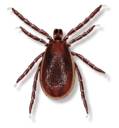
Information
Ticks are well-recognised bloodsucking external parasites of humans, pets, livestock, and wild animals. They also are vectors of a wide variety of disease-causing organisms to animals including humans. Ticks are wingless and possess a single, oval body region that is relatively flat (except when engorged with the host’s blood). Larvae have only six legs while nymphs and adults have eight legs. The head (which is really modified mouthparts known as the capitulum) of a tick includes structures involved in feeding consisting of a pair of leg-like sensory structures known as “palps” that enable the tick to detect an approaching host (known as “questing”), a pair of knife-like structures known as “chelicerae” that cut an opening in the host skin, and a single barbed structure known as a “hypostome” that enters this opening. The hypostome becomes anchored in the host flesh when the tick takes a blood meal. During the attachment process the tick uses its secretions mixed with host skin to form a cement which strongly attaches the tick to the host rendering it difficult to remove.
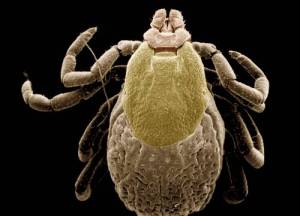
Aetiology
There are approximately 900 species of ticks in the world, of which only a few exist in Ireland. They are broadly divided into two groups – the family Ixodidae, known as “hard ticks,” and the family Argasidae, known as “soft ticks.” Only one species is common in Ireland – Ixodes ricinus – there is a possibility that Dermacentor variabilis may be present here, though this has not been confirmed. The latter species is present in mainland UK. Rhipicephalus sanguineus (brown dog tick) though present in southern Europe is not thought to occur in Ireland. Hard ticks possess the following characteristics that differ from the soft group:
- Structural / anatomical differences – discussed later under diagnosis
- One nymhal stage while soft ticks have several
- Adult feeding time is several days compared to 30-60 minutes for soft ticks
- Females have a single blood meal and single egg laying event while soft ticks have several
- 3-8000 eggs are laid in total by each female while soft ticks only lay 4-500
Photo courtesy of Prof. Dr. H. Mehlhorn, Heinrich Heine University Düsseldorf & Intervet International bv
Epidemiology
The world is host to approximately 900 species of tick, and they’re a problem almost everywhere. Hard ticks have four developmental forms: eggs, larvae, nymphs and adults (male and female). Ixodes ricinus is known as a “3-host tick,” with the following life cycle. Hard ticks quest for passing vertebrate hosts. Questing is a behaviour in which the tick reaches upward with waving front legs ahead of an approaching host. A newly hatched larva usually feed for 3-5 days on insectivores although they may also find rodents, rabbits, birds, reptiles or bats and then drops off to the ground, and moults to a nymph. A nymph seeks out (quests after ascending the grass) and feeds on a second host (usually a small to medium sized mammal), drops off to the ground, and moults to an adult. If they fail to find a host they descend to the moist microclimate at the base of the sward to avoid dehydration and re-quest at a later time. Male and female adults seek out a third host, feed, mate, and drop off to the ground. Males die soon thereafter, while females eventually lay eggs on the soil. Larvae, nymphs, and adults detect carbon dioxide, host odours, vibrations, and warm, moist air currents. The duration of egg laying may last several days to a few weeks. Depending on the species, a single female may lay 3,000 – 8,000 eggs and then dies.
The length of life cycles of hard ticks differ depending on several factors, such as the type of hosts on which they feed, the duration of each developmental stage and which stage survives winter and the species (Ixodes ricinus has a 2-3 year life cycle though it can be as short as 1 year or as long as six). For example, depending on the species, hard ticks may spend winter either as larvae, nymphs, or female adults.
Hard ticks are found in habitats that are populated by a supply of vertebrate hosts, mainly mammals and birds. Some of the most productive habitats are rough grasslands, moist woodlands and areas of vegetation around the edge of forests, along forest trails where a dense mat close to the ground provides a warm moist habitat to harbour developmental stages. There is a seasonal risk period for exposure from April to October, mainly influenced by sufficiently high temperature and humidity in the ticks environment to initiate activity and questing.
Clinical Signs
Clinical signs of tick infestation can result in direct or indirect signs. Direct signs are attributable to the presence of the tick while indirect result from agents carried by ticks – the so called Tick borne diseases. When ticks bite, they can cause a range of signs including:
- Mild skin irritation
- Itching and biting of skin
- Hair loss
- Very heavy infestations in young animals can result in excessive blood loss resulting in anaemia and occasionally death.
Cats, through the nature of their dense fur, harbour significant numbers of ticks unnoticed.
The act of blood feeding by a hard tick results in a local feeding wound. Initially the tick secretes saliva containing compounds that increase blood flow, prevent clotting, and suppress the host’s immune response. Ticks ingest the blood that pools in the wound. Saliva is mixed with skin components to form a cement that facilitates a strong attachment. At the same time as feeding, they regurgitate excess water that has been extracted from the blood meal into the wound. This process increases the possibility for the transmission of pathogens from a tick to its animal host. Transmission of a pathogen generally does not occur until an infected tick has attached and fed for at least 24 hours (the earliest transmission of Lyme Disease has been documented in gerbils to occur at 16.5 hours after initial attachment), and transmission of some pathogens does not begin until an infected tick has fed for 48 hours or more. An exception to this is if a tick becomes partially engorged, becomes detached and then attaches to another host, where disease transmission will occur much earlier in the feeding process. This is thought to be rare however.
Larvae of hard ticks usually complete a blood meal within a day or two and engorge very little. Nymphs attach to a host and complete a blood meal within a few days. They engorge enough that if squashed, they are found to contain significant amounts of blood. Male adults feed much like nymphs, but do so repeatedly on one host animal. The large scutum greatly limits the amount of engorgement by male adults. Female adults attach to a host and, once mated, complete feeding in a week or so. Engorgement is phenomenal over the course of the last day or two of feeding, resulting in a huge increase in body size (see images below). Engorgement of female adults is facilitated by the lack of a large scutum and the possession of an expandable body wall.
| Day 1-2 tick | 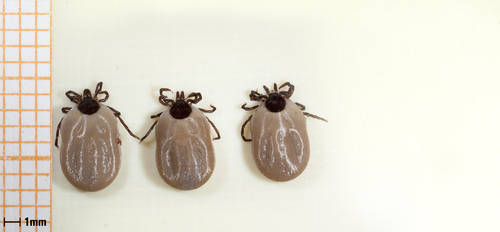 |
| Day 3-5 partially engorged female tick | 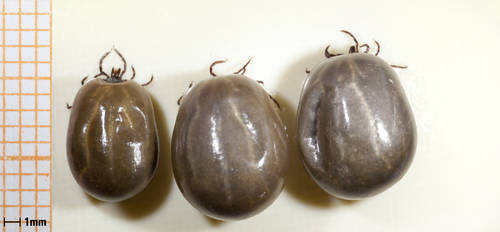 |
| Day 6-7 engorged female tick | 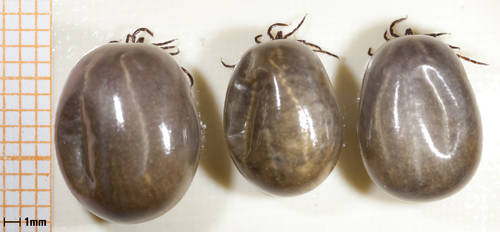 |
INDIRECT
Ticks can also transmit bacterial and parasitic diseases to both animals and humans. In Ireland and the UK, ticks transmit Borrelia burgdorferi – the cause of Lyme Disease. When animals (or humans) are infected with this organism, they can develop variable clinical signs as follows:
ANIMALS
Initially PUO (Pyrexia (fever) of uknown origin) and generalised lymphadenopathy (enlarged glands around the body)
Shifting lameness with palpable effusion in the affected joints
HUMANS
Fever, headache, fatigue, and a characteristic skin rash called erythema migrans or “Bull’s eye rash” around the tick bite. If left untreated, infection can spread to joints, the heart, and the nervous system. Lyme disease is diagnosed based on symptoms, physical findings (e.g., rash, though this may be absent in many cases), and the possibility of exposure to infected ticks. Laboratory testing is helpful if used correctly and performed with validated methods. Most cases of Lyme disease can be treated successfully with a few weeks of antibiotics. Steps to prevent Lyme disease include using insect repellent, removing ticks promptly, applying pesticides, and reducing tick habitat. Further information on Lyme Disease may be found be clicking on the information sheets from the HSE or HPSC respectively. Important to note is the advice on control which includes the importance of control of ticks on pets as part of any preventive strategy.
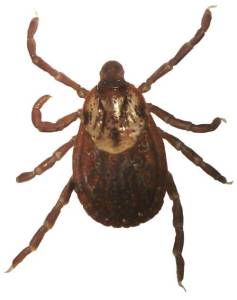
Diagnosis
sometimes be easy to spot, particularly in short and light-colored fur. They are more difficult to find in dark-haired pets. Also, pets may groom the ticks out before you have a chance to see them, so your pet may have recently had ticks, but you may not always see them. Try parting the coat on ventral (lower or downward facing) parts of the body using your hands or a comb and look for characteristic ticks. Hard ticks possess the following characteristics that differ from the soft group:
- Presence of a shield like structure on the dorsum (known as a scutum)
- The mouthparts are extended anteriorly and so are visible from above while the capitulum of the soft tick is ventrally facing
Tick borne disease, principally Lyme Disease in Ireland, may lead to other signs listed above under Clinical Signs.
Control
Two aspects of control exist –
a) Treating an existing infestation
A variety of formulations containing various active ingredients exist for repelling or killing ticks. Presentations include collars, spot-ons, sprays and oral medications. Some products contain insecticidal products that also kill adult fleas. The duration of protection is generally very short with sprays while collars tend to provide more prolonged protection. To achieve the goal of treating existing infestation, you need to use a product that it fast acting as this will result in early resolution of clinical signs and ideally prevent transmission of tick borne disease. Consult your vet for details.
B) Preventing future infestations
To stop repeat infestations, you need to break the tick life cycle once and for all. Veterinary practitioners recommend using tick products on all pets in the house all year-round to maximise likehihood of this break. Using a long acting product is best for achieving prevention of future infestations as it minimises the likelihood of forgetting to treat the animals concerned i.e owner compliance is improved.
MSD Animal Health has introduced an oral medication for fleas and ticks to the Irish market which is both fast acting and long acting. This product can be used both for treating an existing infestation as well as preventing future infestations. Consult your vet for details. Further information is available by clicking here and searching for the spot-on product for cats. You may also view a brief video introducing this novel approach to tick and flea control by clicking here. MSD Animal Health has also introduced a product that treats fleas, ticks and a range of internal parasites (worms) in cats. This product may be administered every 12 weeks. For further information on this product please click here.
